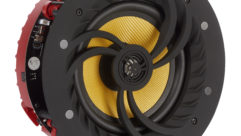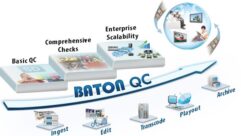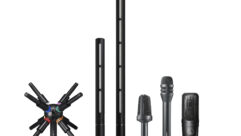CobraNet Technology: Many of today’s audio systems are limited by theircomplex structure. A true audio network can greatly reduce those problems.
Oct 1, 1997 12:00 PM,
Rich Zwiebel
Audio systems have grown significantly more ad-vanced in recent years.Larger systems, which may include a substantial amount of digital sig-nalprocessing, computer control and monitoring, distributed power amplifiersand steerable loudspeaker arrays, are becoming more common as the industrymatures. This growth in capabilities and complexity can be found in allsegments of our industry. As we continue to design and deliver moresophisticated systems, our customers have matured and expect more of theirsystems than at any time before. This is not just occurring in our industrybut is being experienced by all technology providers.
Although all of these advances improve the end product, they have alsoresulted in greater complexity. Most large audio systems now includecontrol systems in addition to the purely audio systems. Distributing poweramplifiers have added to the complexity of the audio wiring. Paging,intercom and announcement requirements have increased. Along with thedistribution of audio processing and amplification devices, audio sourcesare frequently located in many locations.
The increased complexity of these systems has created new problems. Thesesystems place greater demands upon the transmission requirements of thesystem. Adding control and monitoring capabilities to audio processing andamplification products, along with the inclusion of control only products(such as those provided by AMX and Crestron) into systems that werepreviously exclusively audio systems has added an entirely new layer ofwiring to audio systems. More cable and conduit are being included in thedesign. The additional materials and labor to install and troubleshoot thecontrol system wiring has added to the cost as well as time to install andset up these systems. Distributing sources, processing and amplificationhas further added to the infrastructure cost. Many of today’s consultantsand contractors are constrained in their creativity in providing solutionsby the additional burden of this infrastructure. It limits them in terms ofcost and also in terms of capability.
Peak Audio develops products and technological solutions for theprofessional audio industry. The limitations of today’s infrastructure keptcoming up in conversations with industry leaders. Clearly, there was a needfor a true audio network. What is an audio network and how does it differfrom a cabling system? What features would an ideal audio network include?We discussed audio networking with consultants, contractors, operators andmanufacturers. We discovered the following in this study.
A digital networkAnalog signals are far more susceptible to noise interference than aredigital ones. In fact, delivering digital signals over fiber-optic cablecreates a completely electrically isolated system that is immune to noisepickup.
Other advantages offered by digital transmission are that digital signalscan be carried over inexpensive, unshielded twisted pair cable. It is morecost effective to multiplex digital audio over a single pair of conductorsthan analog audio. It is also possible to carry other data, such as controldata, over the same pair of conductors. The ability to carry multiplechannels of audio along with data over a single pair is a big advantage,both in cost and complexity. Digital technology can provide for errordetection schemes as well.
As digital audio products become ever more prevalent, transporting audio inthe digital domain makes more sense because the need for multiple D-to-Aand A-to-D conversions is eliminated. It was clear that any audio networkneeds to be digitally based.
Multiple-access networkThe next important issue was to decide whether the audio distributionnetwork was to be a multiple-access network or a collection ofpoint-to-point connections. A multiple-access network allows any node toact as a source, putting audio and control information onto the network. Italso allows any node to receive audio and control data. A point-to-pointconnection allows audio to be delivered from a single point to anothersingle point. (See Figure 1.)
On a multiple-access network, each device is assigned an address. Any audiosignal on the network can then be routed to any one or any combination ofother devices on the network. This routing can be dynamically assigned. Thenetwork, therefore, acts as an audio router, eliminating the need for thistypically expensive device. Sources can be located throughout a facility,as can receivers. The result is a highly flexible routing system in whichcabling costs are reduced and you eliminate a potential single point offailure in the central router. If this network is bi-directional, alldevice locations can include both sources and receivers. Devices suchmixers can both send and receive over a single cable. (See Figure 2.)
Another advantage is that, because a multiple-access network provides acommunications channel to and from each station, all network devices may bemonitored and managed from a central point. In a single-access system, thetransmitter can control the attached receivers, but because a single-accesssystem is unidirectional, the transmitter cannot monitor the receivers. Infact, it is impossible to determine whether the connection to a givenreceiver has been broken. For this reason, single-access systems are oftenaugmented with a separate control network used to control and monitor endstations on the distribution system. On a multiple access network, thisfunctionality is built in.
Multiple mediaOur research further indicated that the network should be compatible withmore than one type of medium. One medium should be a low-cost, readilyavailable, common cable type, which is easily terminated with low-costterminators. Electricians should be familiar with both the cable andterminations. The network should also be able transport data overfiber-optic cable, which is immune to interference induced from outsidesources, is able to carry a signal great distances without degradation, andis cost effective.
Although the Audio Engineering Society is developing a standard for controlprotocol (AES-24), many existing products from professional audiomanufacturers currently incorporate control capabilities, using existingcommunication technologies, and are deployed in the field. Any audionetwork we came up with had to support these existing protocols as well asthe future AES protocol.
Multiple suppliersThe industry does not want a proprietary, sole-sourced technology.Proprietary schemes offer the industry less flexibility in selection ofproducts and tend to be more expensive. We decided that using acost-effective, existing technology was essential. Of course, the audionetwork must be robust and must not fail. Redundancy schemes must beavailable and easily implemented.
Other industries have been going down this same path. Most of thefacilities that incorporate our systems already are installing networkinfrastructures. HVAC, lighting, computers and security are just a fewfields that are incorporating networks into their system designs. It wouldbe a great benefit to the customer if these same infrastructures could alsotransport the data for the audio, video and control systems.
Requirement summaryThe conclusion of our research indicated that an audio network should beable to do the following:
Transport digital audio.
Carry multiple channels of audio and control data over a single pair.
Function as a multiple-access network.
Offer routing capabilities.
Be easily reconfigured.
Be bidirectional.
Be compatible with low-cost, readily available cable and terminators.
Be compatible with fiber-optic cable.
Be available from multiple vendors.
Transport various forms of control data.
Be cost-effective.
Use existing, well-tested technology.
Offer easily implemented redundancy schemes.
Allow for error detection and monitoring of end devices.
Have the ability to make use of existing infrastructure.
Network technologyWe realized that outside of our industry, networking is a well-establishedfield with many solutions in existence. Rather than start from scratch,only to reinvent the wheel, we embarked on a careful analysis of all of theexisting networking technologies.
An obvious advantage of this approach, as compared to developing aproprietary solution just for our industry, is economic. The market forcomputer networking arguably dwarfs the entire professional audio market.Because of high volumes, off-the-shelf computer networking technology isfar more cost effective than a custom solution. An established networktechnology would offer easy availability of components from multiplesources and a general familiarity, acceptance and knowledge of thetechnology. These existing technologies would also be well-tested innumerous installations.
The disadvantage is that computer networking technology is optimized forcomputer applications. There are technical problems in applying computernetworking technology to audio applications. These include the need todistribute a sample clock over the network and the need for timely anddeterministic network access of audio devices on the network. Some networktechnologies provide solutions to these requirements more readily thanothers. Fortunately there are quite a number of computer networkingtechnologies to choose from. It was essential to carefully examine eachnetworking technology to determine if any is appropriate, and if so toselect the technology that was the best suited for our needs.
Some of the network technologies we examined included Token Ring, FDDI,ATM, IEEE 1394, 10 Base-T Ethernet, 100 Base-T Ethernet, 100 Base-VG (alsoknown as AnyLAN) and Isochronous Ethernet. (For a detailed analysis of eachof these technologies, see Kevin Gross’s paper on the subject atwww.peakaudio.com.)
Our conclusions pointed to both 10 Base-T and 100 Base-T Ethernet. 100 BaseT offers the advantage of 10 times the bandwidth; 10 Base-T is currentlymore cost effective. Ethernet is the most common network in the world -more than 50 million nodes are installed worldwide. Most other industrieshave standardized on Ethernet as their transportation medium. Ethernet usesinexpensive CAT 5 cable or, if desired, can be carried over fiber-opticcable. Electricians are familiar with these cable types, and theterminations are simple and low-cost. Ethernet products are available frommany vendors, and they have been tested on countless projects. Manyexisting Ethernet applications are mission-critical, such as life-supportsystems in hospitals; redundancy schemes exist and are well-tested. Networkmanagement systems exist, and it meets all of our requirements.Furthermore, the cost of the components keeps going down! What a greatopportunity for the professional audio industry, to be able to piggy-backon the computer industry and enjoy prices that are constantly dropping!
CobraNetThe catch with Ethernet is that it was designed for carrying bursty,relatively low-bandwidth computer traffic. If Ethernet is applied to thetask of carrying real-time audio, as is done in many PC multimediaapplications, the results are less than real-time, primarily becauseEthernet uses statistical processes to resolve contention on the network.Because of this, Ethernet can be said to be non-deterministic, especiallywhen carrying heavy loads. This non-deterministic nature means that,although there is a good chance, there is no guarantee that data will bedelivered in a timely fashion. Late delivery will result in audio dropoutsand discontinuities.
Peak Audio’s engineers went to work on this problem, and CobraNet is theresult. CobraNet delivers deterministic performance via Ethernet whileallowing more than 90% of the network bandwidth to be used.
More than 64 channels of studio-quality audio (20 bit, 48 kHz uncompressed)can be carried on a single CAT-5 cable. More than 500 channels ofintercom-grade audio can be carried over this same inexpensive cable. Thisability greatly reduces the cost of conduit and cable in a facility (atypical convention center can be reduced by up to $250,000) whileincreasing the flexibility of the system.
CobraNet allows complete routing flexibility, meaning any input or group ofinputs can be routed to any output or group of outputs in any combinationin a facility. This allows a system to be reconfigured for different eventsor for expansion without rewiring. Audio can remain in the digital domainbetween all digital products on the network, regardless of manufacturer.These products can be located anywhere in the facility that the networkgoes. CobraNet networks can go over distances of up to 2 km on multi modefiber, even further on single mode.
Also, the cable can carry control data. CobraNet is not a control protocol,it is a medium for the transport of these protocols. The network currentlyaccepts RS-422, RS-485 and RS-232 control I/O. When AES-24 is establishedas a standard, it can be carried as well. CobraNet allows control schemesfrom different vendors to co-exist on the same network infrastructure. Theidea here is to reduce the amount of wiring while increasing flexibility.Full redundancy techniques are readily available.
CobraNet-compliant products from various manufacturers can be locatedthroughout a facility. Any node location can provide both sources (inputsto the network) or destinations (audio devices that take audio off of thenetwork). Each CobraNet device is addressable. This means audio from anysource can be routed to any destination, or to as many destinations as aredesired. Thus routing can be accomplished on the network. Only one low-costcable is needed to interconnect all audio locations. This same cablecarries the audio system control data as well. CobraNet technology has thepotential to support delivery of video data as well as audio, though thiscapability has not been incorporated into any products when this articlewas written.
New ideas, new productsThese new capabilities open up many avenues for the system designer. Itprovides a new level of freedom in locating both centralized anddistributed processing. Power amplifiers can be distributed throughout afacility or co-located with loudspeakers without the concern about theadditional complexity and cost of cabling and conduit. In fact, the cost ofthe infrastructure, including cabling, conduit and labor, can be greatlyreduced. Because the network can be easily reconfigured, facilities canaccommodate different types of events easily. Changes in facilities in thefuture can be easily accommodated without a need to rewire. As new productsare introduced, the systems designer will be able to interface audioprocessors, amplifiers, self-powered speakers and control products togetherin a simple, reliable method. Imagine all of the audio products in a soundsystem interconnecting with a simple RJ-45 connector. There might be 64channels of audio, control data, monitoring data and clock data all passingthrough this single connector. This certainly makes wiring the system aneasier task.
In order for a network technology to truly benefit an industry, it must becompatible with the products of many manufacturers. A standard technologythat is not vendor specific and carries multiple control protocols willadvance the industry as a whole and the quality of the systems we provide.This technology is being incorporated into products made by QSC Audio,Level Control Systems, EAW and Crown International, and Rane and PeaveyElectronics have announced forthcoming products. Already manufactured unitsare in successful use at the Sydney Opera House and a large new theme park.
These products and this type of system will allow the audio industry tojoin other industries in taking advantage of network technology. By usingEthernet, the professional audio industry is taking advantage ofdevelopments that are driven by the size of the computer industry. As moreflexible, more intelligent systems are designed in the future, the entireindustry and customers of our industry will benefit from the advent ofnetworked audio systems.
RAVE (Routing Audio Via Ethernet), QSC Audio’s digital audio router system,provides the first practical way for audio data to be routed in real timevia standard Fast Ethernet hardware and cabling. Developed in conjunctionwith Peak Audio, RAVE is the first product on the market to use Peak’sCobraNet Technology.
With RAVE, QSC has created a simplified way to overcome the problems thatcan occur with audio distribution, analog or digital. RAVE units are easyto use, require no complicated configurations and are extremely costeffective. Because RAVE is designed to use standard 100BaseTX Ethernetperipherals, the units can easily be used by consultants and contractorseverywhere.
RAVE units recently solved an audio dilemma at Six Flags Over Georgia. Thenew hour-and-a-half “Gotham City Circus Nights” show had an audio controlroom located 500 feet (152 m) from the audio sound room. It was a questionof how to get audio from “here” to “there” efficiently and reliably.
“Running shielded analog lines would have been costly and not thatreliable, and fiber was too expensive,” explained T. Neil Garner, audioengineer for the park. “RAVE was the perfect answer. The units provide uswith everything we need and then some. We have four channels of audio forthe show, three returns to use for audio monitoring, and one channel to usefor communication purposes between the two rooms. In addition, they areeasy to use and even easier to install.”
Individual RAVE units can handle 16 channels of audio inputs or outputs or,as was the case with Six Flags, eight channels of each. In RAVE’s simplestform, 16 channels of audio (or eight channels bi-directionally) can bedistributed from point A (RAVE unit 1) to point B (Rave unit 2) via FastEthernet over a distance of up to 300 feet (91m). Any number of RAVE unitscan be linked with a maximum total distribution of 64 channels of audio.The only restriction is the distance audio can be distributed over Cat 5Ethernet cable, approximately 320 feet node-to-node (98 m) or 670 feet (204m) total. However, the addition of a Fast Ethernet media converter (TX toFX) at the distribution point allows the signal to be distributed viafiber-optic cable, which can provide cable runs of over 2 km (1.24 miles).
That was exactly the case with the half-time entertainment system at SuperBowl XXXI. The RAVE units not only distributed digitized audio convenientlyand efficiently on two separate Fast Ethernet networks, but they alsofacilitated the ability to convert to fiber optics in order to link thefar-flung distributed system.
Gary Hardesty, vice president of EAW and entertainment system designer forSuper Bowl XXXI, noted, “RAVE components simplified the use of fiber opticsand digital audio distribution in a sophisticated system like the one usedat the Super Bowl. But I can see them providing benefits to any sizedistributed system.”
Designing RAVE for use with 100BaseTX Ethernet offers numerous advantages.End users understand Ethernet networks. Ethernet networks are economical;the potential savings of 15% to 75% through reductions in cabling,termination, conduit and installation costs is something most end users canunderstand. Ethernet networks are also flexible – distribution points canbe added or subtracted with convenient, off-the-shelf Ethernet peripherals.
Audio routing is also simplified. Each unit distributes blocks of eightaudio channels, which can be transmitted or accessed at any point on thenetwork. The routing is determined by two routing switches located on theremovable front panel on each RAVE unit. The end result is a system that isflexible, versatile and easily adapted or expanded to service variousconfigurations.










